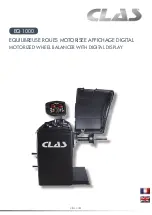
Use and Maintenance Manual – VER. 2016-02
Page 1
CONTENTS
1.
Introduction
P. 2
2.
Intended use
P. 3
3.
General safety rules
P. 3
3.1 Safety devices
P. 3
4.
Transport and handling
P. 3
5.
Unpacking
P. 4
6.
Installation and commissioning
P. 4
6.1 Electrical connection
P. 4
7.
Installation
P. 5
8.
Use suspension
P. 5
9.
Environmental information
P. 6
10. Technical data
P. 6
10.1 Machine dimensions
P. 6
10.2 Working range
P. 7
10.3 Presentation of the machine
P. 8
11. Serial number plate information
P. 8
12. Ordinary maintenance
P. 8
13. Control panel
P. 9
13.1 Keyboard
P. 10
13.2 NORMAL, SERVICE, STAND BY operating modes
P. 11
14. Temporary diameter and distance sensor disabling
P. 11
15. Machine calibration
P. 12
15.1 When to carry out machine calibration
P. 12
15.2 Machine calibration for the TRUCK wheel type
P. 12
15.3 Machine calibration for the CAR/SUV wheel Types
P. 14
16. Use of the machine in normal mode
P. 15
16.1 Program Type
P. 16
16.2 Wheel type
P. 17
16.2.1 CAR wheel type
P. 17
16.2.2 TRUCK wheel type
P. 17
16.2.3 SUV wheel type (off-road vehicles)
P. 18
16.3 Entering wheel size
P. 18
16.3.1 Manual entry of wheel dimensions for the STD and Program Types
P. 18
16.3.2 Manual entering of the wheel dimensions for ALS1, ALS2 program types
P. 19
16.3.3 Automatic acquisition of wheel dimensions for STD Program Types
P. 21
16.3.4 Automatic acquisition of the wheel dimensions for the ALS1, ALS2 program types
P. 21
16.4 Use of the special program types for ALS1 and ALS2 aluminium wheels
P. 22
16.4.1 Acquisition of the balancing planes
P. 23
16.4.2 Balancing spin
P. 24
16.4.3 Search of the balancing planes
P. 24
16.4.4 Use of the ALS1 or ALS2 program types without automatic acquisition
P. 25
16.4.5 Use of the Program Types ALS1 or ALS2 without the preliminary acquisition of balancing planes P. 25
17. Hidden weight program
P. 26
18. Second operator
P. 28
19. Utility programs
P. 29
19.1 Selection of the imbalance display resolution
P. 29
19.2 Selection of the static imbalance display
P. 30
19.3 Electromagnetic clamping brake
P. 30
19.4 SWI wheel stop procedure on the positions of imbalance
P. 30
19.4.1 Automatic SWI procedure
P. 31
19.4.2 SWI procedure at low speed
P. 31
19.4.3 Manual SWI procedure
P. 31
19.5 Low speed rotation
P. 32
20. Service mode
P. 32
21. Signalling
P. 37
21.1 Error codes
P. 37
21.2 Acoustic signals
P. 38
21.3 Special visual signals
P. 39
Summary of Contents for VULTURE BP46
Page 1: ...BP46 VULTURE ...



















